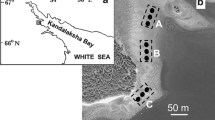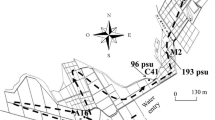Abstract
The design and construction of a closed system circulating sea-water tidal estuarine sediment microcosm is described. The microcosm was used to culture mixed species populations of the Harpacticoida (Crustacea: Copepoda) and the evolution of the community and the successional changes are detailed. The communities that developed in each of four replicate microcosms were statistically indistinguishable with respect to the species richness, the numbers of individuals recorded, the log series diversity and the dominance diversity statistics. The most abundant species were the same in each microcosm with the same rank. A diverse community was maintained that did not tend to monoculture; however, the successional changes observed were not apparent in the estuarine communities from which the culture sediments was collected. Rather than a functional reorganisation of the community effecting this, gross environmental changes resulting from a decreased depth of sediment matrix are implicated. The success in maintaining a diverse community is attributed to a provision of a number of nutrient sources.
Similar content being viewed by others
Literature Cited
Andrews, A. R., G. D. Floodgate, and K. B. Pugh: An annual cycle at constant temperature in a model sandy beach. II. Microbial ecology. J. exp. mar. Biol. Ecol 24, 61–72 (1976)
Bell, S. S.: Short-and long-term variation in a high marsh meiofauna community. Estuar. coast. mar. Sci. 9, 331–350 (1979)
Berger, W. V. and F. L. Parker: Diversity of planktonic Foraminifera in deep-sea sediments. Science, N.Y., 168, 1345–1347 (1970)
Berghe, W. V. and M. Bergmans: Differential food preferences in three co-occurring species of Tisbe (Copepoda, Harpacticoida). Mar. Ecol. Prog. Ser. 4, 213–219 (1981)
Bernhard, M.: Chemical contamination of culture media: assessment, avoidance, and control. In: Marine ecology: a comprehensive, integrated treatise in life in oceans and coastal waters. Vol. 3, Part 3. Chapter 7, pp 1459–1499. Ed. by O. Kinne. Chichester: Wiley 1977
Bernhard, M. and A. Zattera: The importance of avoiding chemical contamination for a successful cultivation of marine organisms. Helgol. wiss. Meeresunters. 20, 665–675 (1970)
Bernhard, M., A. Zattera: and P. Filesi: Suitability of various substances for use in the culture of marine organisms. Pubbl. Staz. zool. Napoli 35, 89–104 (1966)
Boswell, M. T. and G. P. Patil: Chance mechanisms generating the logarithmic series distribution used in the analysis of number of species and individuals. In: Statistical ecology. Vol. 1, pp. 121–134. Ed. by G. P. Patil, E. C. Pielou, and W. E. Waters. Philadelphia: Pennsylvania State University Press 1971
Boucher, G.: Evolution des caracteristiques chimiques et biologiques des sediments en circuit clos. II. Effets de la matiere organique circulante sur la meiofaune de systemes polytrophes. Publ. Sci. Tech. CNEXO: Actes Colloq. 7, 31–47 (1979)
Boucher, G. and S. Chamroux: Bacteria and meiofauna in an experimental sand ecosystem. I. Material and preliminary results. J. exp. mar. Biol. Ecol. 24, 237–249 (1976)
Cantelmo, F. R. and K. R. Rao: Effects of pentachlorophenol (PCP) on meiobenthic communities established in an experimental system. Mar. Biol. 46, 17–22 (1978)
Chamroux, S. and G. Boucher: Evolution des caracteristiques chimiques et biologiques des sediments en circuit clos. I. Azote et population bacteriennes en function de certain parametres du milieu. Publ. Sci. Tech. CNEXO: Actes Colloq. 7, 17–30 (1979a)
Chamroux, S. and G. Boucher: Evolution des caracteristiques chimiques et biologiques des sediments en circuit clos. III. Bilan azote de systemes polytrophes. Publ. Sci. Tech. CNEXO: Actes Colloq. 7, 49–56 (1979b)
Chamroux, S., G. Boucher, and P. Bodin: Etude experimentale d'un ecosystem sableaux. II Evolution des populations de bacteries et de meiofaune. Helgol. wiss. Meeresunters. 30, 163–177 (1977)
Coull, B. C.: Estuarine meiofauna: review, trophic relationships, and microbial interactions. In: Estuarine microbial ecology, pp. 499–511. Ed. by L. H. Stevenson and R. R. Colwells. Columbia: University of South Carolina Press 1973
Cox, J. L.: Sampling variation in sandy beach littoral and nearshore meiofauna and macrofauna. US Coastal Engineering Research Center, Fort Belvoir, Virginia, Tech. pap. No. 76-14, 54 pp., 1976
Dyer, D. L. and D. E. Richardson: Materials of construction in algae culture. Appl. Microbiol. 10, 129–131 (1962)
Elmgren, R. and J. B. Frithsen: The use of experimental ecosystems for evaluating the environmental impact of pollutants: a comparison of an oil spill in the Baltic Sea with two long-term, low level oil addition experiments in microcosms. Symposium on enclosed experimental marine ecosystems, Sidney, Canada, Aug. 13–16, 1980 (In press)
Elmgren, R., G. A. Vargo, J. F. Grassle, J. P. Grassle, D. R. Heinle, G. Langlois, and S. L. Vargo: Trophic interations in experimental marine ecosystems perturbed by oil. In: Microcosms in ecological research, pp. 779–800. Ed. by J. P. Giesy. Augusta: U.S.A. Dept. Energy 1981
Fisher, R. A., A. S. Corbett, and C. B. Williams: The relation between the number of species and the number of individuals in a random sample of an animal population. J. Anim. Ecol. 12, 42–58 (1943)
Gardner, M. R. and W. R. Ashby: Connectance of large dynamical (cybernetic) systems: critical values of stability. Nature, Lond., 228, 784 (1970)
George, I. D.: The culture of benthic polychaetes and harpacticoid copepods on agar. 10th Eur. Symp. Mar. Biol., Ostend, Belgium, Sept. 17–23, 1975. Vol. 1, pp. 143–149. Wetteren: Universa Press 1976
Gerlach, S. A.: Attraction to decaying organisms as a possible cause for patchy distribution of nematodes in a Bermuda beach. Ophelia 16, 151–165 (1977)
Gerlach, S. A.: Food-chain relationships in sub-tidal silty marine sediments and the role of meiofauna in stimulating bacterial productivity. Oecologia 33, 55–69 (1978)
Grassle, J. F., R. Elmgren, and J. P. Grassle: Response of benthic communities in MERL experimental ecosystems to low level, chronic additions of No. 2 fuel oil. Mar. environ. Res 4, 279–297 (1981)
Gray, J. S.: An experimental approach to the ecology of the harpacticid Leptastacus constrictus Lang. J. exp. mar. Biol. Ecol. 2, 278–292 (1968)
Hansen, D. J.: Aroclor 1254: effect on composition of developing estuarine animal communities in the laboratory. Contr. mar. Sci., Univ. Texas 18, 19–33 (1974)
Hardy, B. L. S.: A method for rearing sand-dwelling harpacticoid copepods in experimental conditions. J. exp. mar. Biol. Ecol. 34, 141–147 (1978)
Harris, R. P.: Reproductive activity of the intertidal copepods of a sandy beach. J. mar. biol. Ass. UK 52, 507–524 (1972)
Heinle, D. R.: Culture of calanoid copepods in synthetic seawater. J. Fish. Bd. Can. 26, 150–153 (1969)
Hicks, G. R. F.: Observations on substrate preference in marine phytal harpacticoids (Copepoda). Hydrobiol. 51, 7–9 (1977)
Hockin, D. C.: A simple elutriator for extracting meiofauna from sediment matrices. Mar. Ecol. Prog. Ser. 4, 241–242 (1981)
Hockin, D. C. and J. G. Ollason: The colonization of artificially isolated volumes of intertidal estuarine sand by harpacticoid copepods. J. exp. mar. Biol. Ecol. 53, 9–29 (1981)
Johnston, R.: The decomposition of crude oil residues in sand columns. J. mar. biol. Ass. UK 50, 925–932 (1970)
Kendall, D. G.: On some modes of population growth leading to R. A. Fisher's logarithmic series distribution. Biometrika 35, 6–15 (1935)
Kinne, O.: Crustacea. In: Marine ecology: a comprehensive, integrated treatise in life in oceans and coastal waters. Vol. 3, Part 3, pp. 761–766. Ed. by O. Kinne. Chichester: Wiley 1977
Lasker, R., J. B. J. Wells, and A. D. McIntyre: Growth, reproduction, respiration and carbon utilisation of the sand-dwelling copepod, Asellopsis intermedia. J. mar. biol. Ass. UK 50, 147–160 (1970)
Leach, J. H.: Hydrology of the Ythan estuary with reference to distribution of major nutrients and detritus. J. mar. biol. Ass. UK 51, 137–157 (1971)
Lee, J. J., J. H. Tietjen, C. Matropaolo, and H. Rubin: Food quality and the heterogeneous spatial distribution of meiofauna. Helgol. wiss. Meeresunters. 30, 272–282 (1977)
Lewis, A. G., A. Ramnarine, and M. S. Evans: Natural chelators—an indication of activity with the calanoid copepod Eucheta japonica. Mar. Biol. 11, 1–4 (1971)
Marshall, S. M.: Respiration and feeding in copepods. In: Advances in marine biology, Vol. 11, pp. 57–120. Ed. by F. Russell and M. Young. London: Academic Press 1973
Munro, A. L. S., J. B. J. Wells, and A. D. McIntyre: Energy flow in the flora and meiofauna of a sandy beach. Proc. R. Soc. Edinburgh 76B, 297–315 (1978)
McIntyre, A. D., A. L. S. Munro, and J. H. Steele: Energy flow in sand ecosystems. In: Marine food chains, pp. 19–31. Ed. by J. H. Steele. Edinburgh: Oliver and Boyd 1970
McLachlan, A., A. Dye, and B. Harty: Simulation of the intertidal system of exposed sandy beaches. Estuar. coast. Shelf Sci. 12, 267–278 (1981)
Nixon, S. W.: A synthetic microcosm. Limnol. Oceanog. 14, 142–145 (1969)
Omori, M.: Cultivation of marine copepods. Bull. Plank. Soc. Jap. 20, 3–11 (1973)
Osman, R. W. and R. B. Whitlach: Patterns of species diversity: fact or artifact? Paleobiol. 4, 41–54 (1978)
Peterson, C. H.: Species diversity and perturbations: predictions of a non-interactive model. Oikos 29, 239–244 (1977)
Pugh, K. B.: A model beach system. J. exp. mar. Biol. Ecol. 18, 197–213 (1975)
Pugh, K. B.: An annual cycle at constant temperature in a model sandy beach. I. Nutrient chemistry. J. exp. mar. Biol. Ecol. 22, 179–192 (1976)
Ravenal, W. S. and D. Thistle: The effect of sediment characteristics on the distribution of two subtidal harpacticoid species. J. exp. mar. Biol. Ecol. 50, 289–301 (1981)
Ringelberg, J. and K. Kersting: Properties of an aquatic microecosystem. I. General introduction to the prototype. Arch. Hydrobiol. 83, 47–68 (1978)
Rosenfield, D. C. and B. C. Coull: Adult morphology and larval development of Paramphiascella fulvofasciata n. sp. (Cop., Harp.). Cah. biol. Mar. 15, 295–317 (1974)
Skellam, J. G.: Phylogeny as a stochastic process. Abstract no. 144. Biometrics 7, 121 (1951)
Taub, F. B.: A biological model of a freshwater community: a gnotobiotic system. Limnol. Oceanog. 14, 136–142 (1969)
Vitiello, P.: Variation de la densite du microbenthos sur une aire restreinte. Rec. Trav. st. mar. d'Endoume 43, 261–270 (1968)
Watterson, G. A.: Models for the logarithmic series abundance distribution. Theor. Pop. Biol. 6, 217–250 (1974)
Wormald, A. P. and H. P. Stirling: A preliminary investigation of nutrient enrichment in experimental sand columns and its effect on tropical intertidal bacteria and meiofauna. Estuar. coast. mar. Sci. 8, 441–457 (1979)
Author information
Authors and Affiliations
Additional information
Communicated by O. Kinne, Hamburg
Rights and permissions
About this article
Cite this article
Hockin, D.C. Maintenance of a diverse harpacticoid copepod community in microcosm culture. Mar. Biol. 65, 209–214 (1981). https://doi.org/10.1007/BF00397087
Accepted:
Issue Date:
DOI: https://doi.org/10.1007/BF00397087




